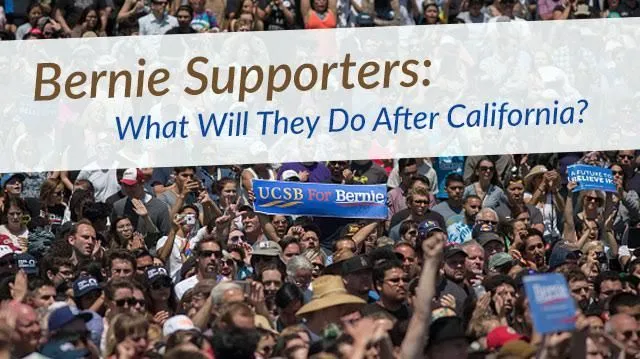
- Share on Facebook36
- Share on Pinterest
- Share on Twitter
We’re about a week from a very big day for American politics. Many states, including New Jersey, Montana, North Dakota and Iowa will hold their Democratic primaries on June 7. Most importantly, the powerhouse California primary also will take place, with a whopping 475 delegates at stake. Hillary Clinton is just a few dozen delegates short of the Democratic nomination, but Sen. Bernie Sanders isn’t giving up yet.
Interestingly, a recent poll projects that while Clinton would lose to presumptive GOP nominee Donald J. Trump in a the general election, while Sanders would beat the Manhattan billionaire by nearly 11 points. Even without a realistic path to the Democratic nomination, it’s clear why the Vermont senator is staying in.
A third-party bid?
If all else fails, Sanders could continue his presidential bid as a third-party candidate. As a self-proclaimed democratic socialist who has run as an independent during his other campaigns, differentiating from the Democratic Party may align better with his nontraditional views. Chances are he still wouldn’t become president, but that is not the point.
Regardless of the plausibility of a win, a last-ditch effort under a third-party ticket would send a message. His entire presence in this presidential race so far would be characterized less as a failed campaign and more as a movement. His many voters find the Sanders platform resonates with them and clearly they are tired of establishment politics; many would follow him to a third-party run.
If Sanders decides not to continue on after California, then where do his supporters turn? This is a complicated question: One can’t assume his voters automatically default to Clinton. Sanders has drawn in a wide variety of voters for a multitude of reasons, so who these people vote for ultimately (if they vote at all) boils down to why they are rallying around Sanders in the first place.
Voters who align mostly with his anti-establishment views could potentially (and maybe somewhat begrudgingly) even shift over to the Trump camp, as many people are eager for an anti-politician, regardless of who it is.
‘Something different’
Similarly, voters who pay less attention to what is going on in politics might simply be hearing that Sanders and Trump are shaking things up, prompting a default to Trump because it’s “something different.” There are even those who see similarities between the two prominent men in the race. According to a recent article in The Atlantic, Trump and Sanders seem to align on some important issues, such as their dislike of the Trans-Pacific Partnership trade deal and their desire to expand Social Security.
On the other hand, the #NeverTrump voter mostly means votes for Clinton. Even some well-known Republicans have said they’ll vote Clinton just to make a point of defying Trump’s takeover of the GOP.
Diehard Democrats, meanwhile, should make an easy pivot over to Clinton, but even then some cannot seem to get behind her, citing the many stains on her record.
‘Bernie or bust’ voters might not vote
Gary Johnson, a former governor of New Mexico, could be a decent alternative. In recent days, the Libertarian party front-runner has gained some traction in the political conversation, with some polls reporting that he would get 10 percent of Americans’ votes. The conservative wing of the GOP is threatening to mount a spoiler candidate to deny Trump the election. Then there is Jill Stein of the Green Party, who has received the least attention of all.
Newspapers and pundits cite a “Bernie or Bust” phenomenon, voters who say they will only vote for Sanders and pledge to write him in if he isn’t on the ticket or vote for someone else. These folks say that they are tired of what they see as a rigged system forcing them to choose between the “lesser of two evils.”
Some might not vote at all. The idea of not voting is questionable, but if one’s belief is that the system is rigged, the perspective makes some sense. If they still won’t quit on Sanders, there’s always the write-in as a last resort.
Perhaps these voters who want to turn their backs on politics altogether will unite behind Sen. Sanders’ ideas and take their protests elsewhere. “Take On Wall Street” might be the latest movement for this demographic to get behind. According to The Washington Post, this group of labor unions and activists is the Occupy Wall Street movement of 2011 “grown up.”
Going after Wall Street
The group’s main goals include going after Wall Street, reducing tax loopholes for money managers and CEOs and breaking up the big banks — signature Sanders ideas. If he decides to step down after California, perhaps Sanders could be their leader.
Jane Sanders, the senator’s wife, recognizes that the momentum should continue in one way or another. As she told The Washington Post, “If he’s president, he wants to keep this movement going. If he’s not president, he’ll have to keep this movement going for a lot more reasons, because nobody else wants to accomplish what has ignited the interest of the voters.”
No matter what his supporters decide to do, it’s going to continue to be an interesting several months leading up to November.
—Brett Murphy Hunt
Sources:
http://www.mytimetovote.com/2016-Primary-Election-Dates.html
http://www.huffingtonpost.com/h-a-goodman/hillary-clinton-now-loses_b_10102664.html
http://www.latimes.com/opinion/op-ed/la-oe-mcmanus-what-sanders-should-do-20160507-8-story.html
http://www.theatlantic.com/notes/2016/01/what-bernie-sanders-and-donald-trump-have-in-common/422907/
- Share on Facebook36
- Share on Pinterest
- Share on Twitter

